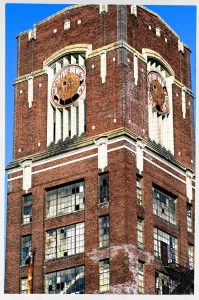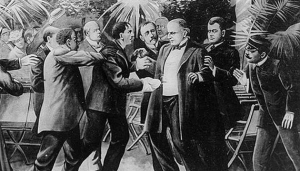| Origins | Settled in 1836 and annexed c. 1863 |
|---|---|
| Area | Southwest Side |
| Boundaries | Stevenson Expressway on the north, Pershing Road on the south, Chicago River on the east, railroad tracks to Artesian Road on the west |
| Gangs headquartered | Spanish Cobras, Satan Disciples, Latin Counts, C-Notes, |
The area was first settled in the year 1836 when Irish immigrants that came to the United States to work on the Illinois & Michigan Canal settled here unofficially once they started work in 1836. The Irish workers were not allowed to live here and were in a way trespassing because they did not officially purchase this land.
In the year 1840 a group of farmers officially purchased the land and pushed out the Irish squatters and the area remained a barren farmland until the canal and railroad system was complete in 1857. Settlement slowly came to this area then grew a little more once Union Rolling Mill opened during the Civil War.
In the year 1863 this area was annexed into the city of Chicago. The main area of McKinley Park that was built up in the 1850s and up through the Civil War was an area known as “Mount Pleasant” which is where Ashland Avenue and Archer Avenue meet. This area was swamp land that was infested with tons of mosquitos and the homes were subject to flooding if they did not build the homes on stilts.
The neighborhood had a problem with garbage early in history because residents asked scavenger passersbys to dump their ashes in the lower areas near the river to prevent more swampy conditions; however, the passerbys often dumped their trash instead.
After the Great Chicago Fire of 1871 Irish, German, Swedish and English immigrants settled in the area and began to build a community as they took up the many industrial jobs in the area and worked in the Union Stock Yards nearby.

This neighborhood became a thriving working-class community and in the 1900s decade as Polish immigrants settled in the area especially after the Central Manufacturing District (pictured right) opened in 1905 and the Pepsi – Cola bottling plant was opened, there was also the Chicago Sun – Times that opened.

In 1902 the actual park in the neighborhood McKinley Park was opened and named after the recently assassinated president William McKinley (pictured left), from there the whole neighborhood was named “McKinley Park.” The area continued to thrive as a stable working-class community.
McKinley Park did have greaser gangs in the 1960s and 1970s and South Side Heads watched over this area in the 1970s but these streets were rather free of gang issues. In the late 1970s Hispanic migration swept the Brighton Park, Gage Park, Bridgeport, Back of the Yards and Marquette park areas but McKinley Park was less settled until the year 1983. During that year Hispanic migration mushroomed as Mexican migrants and many long time Mexican families came to this neighborhood for a better life. What they did not plan on was Hispanic gangs moving alongside this migration. This angered many white youths and much of the white community here because there was the fear Hispanic people would bring gangs and crime. At no fault of the Mexican community Hispanic gangs still settled these streets and racial conflicts soon developed.
The Insane Popes gang from Archer Heights had a new zealous leader that had an aggressive plan to open new Pope territories in racially changing south side neighborhoods this is when 34th and Hoyne became the ideal spot for the Insane Popes to settle here, the Insane Popes then became very popular recruiting hundreds of members. Many times the Popes would bully groups of Hispanic youths drawing Mexican youths to join the newly arrived Satan Disciples and Spanish Cobras. The Popes had a long history already of rivalry with Spanish Cobras and Satan Disciples and war ensued. The Latin Counts also arrived by Popes and Counts had a long history of being allies. Both gangs are part of the People alliance as well. There was now a war between Counts and Popes against Satan Disciples and Spanish Cobras. McKinley Park in the 1980s became one of Chicago’s more dangerous neighborhoods due to some intense gang violence.
In the 1990s these four gangs still dominated these streets. There would be the arrival of some temporary groups like Saints and Party Players. The 1990s was perhaps the most violent decade in McKinley Park history.
In the 2000s decade the C-Notes arrived and flipped several members of the Insane Popes. The C-Notes then became a dominating group in this community. Popes eventually decreased their presence to 34th and Hoyne where they would remain permanently. C-Notes would clash with Satan Disciples but have been very close to Spanish Cobras. C-Notes would also war with latin Counts. Latin Counts, Satan Disciples and Spanish Cobras continued to be dominant groups.
In the 2010s and later the dominating gangs have been Spanish Cobras, Satan Disciples, Latin Counts and C-Notes.
In the 21st century the neighborhood has experienced a decrease in gang activity and violence; however, the area still does have gang activity; however, this is not one of the more violent neighborhoods of the city despite to gang activity. It is on the rougher side but not a dangerous community and very livable.
Party Players 90s
36th & Seeley 90s
Latin Counts Established 1983-present years
35th to 37th, Hoyne to Honore (Honore City) Established 1983-present years
Saints 90s
38th from Honore to Wood 90s
Satan Disciples Established 1983-present years
Archer to 36th, Damen to Ashland (Wild Wood, Dark Side) Established 1983-present years
C-Notes 2000s-present years
33rd to 34th, Leavitt to Damen 2000s-present years
Spanish Cobras Established 1983-present years
35th to 36th, Western to Oakley Established 1983-present years
Insane Popes (south side group) Established 1983-present years
33rd to 35th, Damen to Claremont (Ghost Town, Hoyne Park, R.I.P Reaper)
